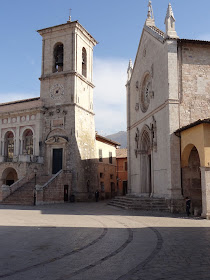Norcia is a small picturesque town nestled in the southeastern region of Umbria, completely enclosed by its 14th century walls and surrounded by the spectacular snow capped mountains of Monti Sibillini Park. With a great culinary history, this ancient town is famous for its lentils, prized black truffles, cheese and renowned brancaleone and dried salumis. The name salumi traces its roots back to 'sale' from its traditional salt curing process. Each type of salumi is known by the kind of meat and process by which it's cured, and in Norcia, because most of the meat come from wild boar, it's not surprising that heads of tusked cinghiale are hung in decoration outside many of the Norcerias throughout the town.
Porta Romana marks the start of Corso Sertoio which leads to the heart of the town
One of the original Roman gates, Porta Romana, guards entry to the ancient town of Norcia, and marks the start of Corso Sertoio, which leads to many of the town's food shops and Piazza San Benedetto, the heart of the town since the Middle Ages. At its centre is a statue of St Benedict, founder of the oldest monastic order in the Western world, and who was born in Norcia along with his twin sister Sta Scholastica.
The statue of St Benedict in Norcia's central Piazza San Benedetto
Norcia's Piazza San Benedetto with the Palazzo Commune (L) and Church of San Benedetto (R)
The 14th century soaring bell tower of Palazzo Communale
San Benedetto with Sta Scholastica and St Benedict
These days however, Norcia is known above all for its local produce. In this tiny southeastern Umbrian outpost of Norcia, artisanal culinary traditions endure. Pecorino cheese is aged for two years, trained dogs sniff out black truffles in the woodlands, and honey is sourced from the red wildflowers that bloom in the plains. But it’s the cinghiale that takes pride of place. Pork, king of the Umbrian table, is at its best in Norcia, a town so renowned for its butchers that the Italian word for pork butcher is 'norcino'.
Stuffed heads of cinghiale can be fund outside most of Norcia's salumi shops
Throughout the centro storico, the scent of spiced wild-boar salumi carries from the norcineria into the traffic-free pedestrian friendly roads. Step past the prosciutti hanging in storefronts to find shopkeepers curing cuts of the pork with methods perfected over the past 800 years, like Brancaleone da Norcia on Corso Sertoria run by Michael, who offered us a thick slice of his delicious prosciutto — and we were hooked. With a small package of sliced prosciutto for antipasto tonight, and a whole shrink-wrapped leg to smuggle back to Canada at the end of the month, we left swinging our loot and headed into the next shop in search of Norcia's prized lentils of Castelluccio.
Michael, owner of Brancaleone da Norcia, where we bought thick slices
of his hand carved Prosciutto di Norcia
Whole legs of Brancaleone da Norcia which can be purchased for about 80 to 100 euros
Castelluccio di Norcia
Cultivated since time immemorial in this mountainous region of Italy, legumes deserve almost an entire page to themselves in the Umbrian food bible. The perfect example is the renowned lenticchie di Castelluccio, which are the most sought after in Italy and indeed, around the world. Small and green, they contain a large amount of protein and mineral salts, and are so tender that they require no soaking. They're also a delicious ingredient to many kinds of flavourful Umbrian meat stews, from rabbit to game and any kind of sausage.
Black and white Norcia tartufo fresca
The secrets of Umbrian cooking are ingredients such as black truffles from Norcia, lentils from the plateau of Castelluccio, lamb provided by local farms around Monti Sibillini National Park, Chianina beef from the pastures of the Visso area, pork from small farms in Pieve Torina, salumi prepared by small producers according to local traditions and fresh ricotta cheese from local artisans. So it's with prized black truffles, tiny lentils from Catelluccio, thick sliced brancaleone and a whole leg of Prosciutto di Norcia, that we pack in our car and head back to Casa del Lauro, to stock our pantry with visions of sumptuous candlelit dinners to come, over the upcoming week.
Castelluccio Lentils with Pancetta and Aromatic Herbs
(Lenticchie di Castelluccio con Pancetta ed Erbe Aromatiche)
Serves 6
The tiny lentils from the Umbrian town of Castelluccio are prized across Italy for their earthy, sweet taste and their ability to maintain their shape even after long simmering.
1 1/2 cups Castelluccio lentils
2 tbsp extra-virgin olive oil
1 medium yellow onion, minced
1 celery stalk, chopped
4 carrots, chopped
1/4 pound Pancetta, excess fat removed and diced
1/4 tsp chili flakes
2 garlic cloves, minced
6 sage leaves, minced
6 thyme sprigs, leaves only, chopped
2 bay leaves
6 cups chicken broth, plus extra as needed
2 tbsp strained Italian canned tomatoes
1/2 tsp salt
1/4 tsp freshly ground black pepper
Rinse the lentils, pick them over and set aside. Heat 1 tablespoon of the olive oil in a large pot and add the onion, celery, carrots, Pancetta, chili, garlic, sage, and thyme. Cook for 10 minutes over medium heat, covered, or until the onion is soft and golden, stirring frequently.
Add the lentils and bay leaves, and sauté for two minutes, stirring gently. Add the broth, covering the lentils by 1-inch adding more if needed. Add also the tomatoes and salt, and bring to a boil, stirring and then cover. Cook over medium-low heat for 90 minutes, or until the lentils are soft but not falling apart. Add a little more broth or water if needed. The consistency should be thick, not soupy. Adjust the salt as needed.
Serve hot, drizzled with the remaining tablespoon of olive oil and sprinkled with the pepper. This is delicious served with grilled sausages.













No comments:
Post a Comment